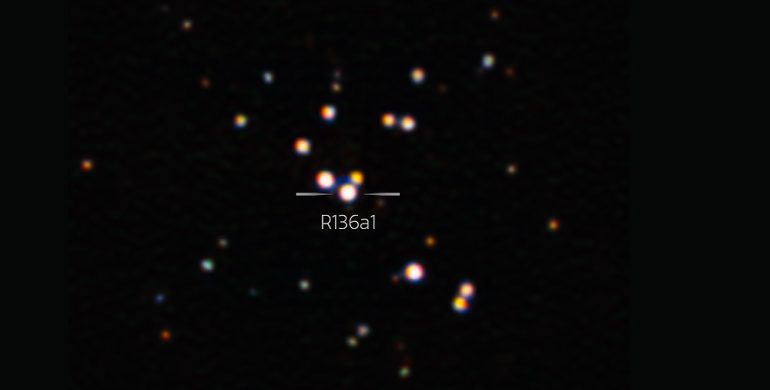Stellar giant: The largest known star in the universe is apparently much lighter than previously thought. It reveals the sharpest image ever taken of the giant star R136a1 in the Large Magellanic Cloud. Accordingly, the stellar giant “only” weighs about 196, instead of the previously estimated 250 to 320 solar masses. While R136a1 is still the heaviest star known, its lower mass sheds new light on the mass ceiling of stars and the demise of such giants.
Giants have short lives: the more massive a star, the less time it takes to use up its fusion fuel. So stellar giants of 100 and more solar masses burn up after only a few million years and explode into a supernova. they use a lot heavy elements free. Massive stars, which were particularly common in the early universe, thus created important prerequisites for planets and eventually for life.
hiding in the crowd
But what is the maximum weight a star can have? And how do these giants end? So far no clear answer has been found to any of these questions. However, astronomers suspect that the most massive stars end up in a special type of supernova: the explosion in this pair-instability supernova is so violent that the star collapses completely, leaving no neutron star or black hole behind. goes. However, it can also be predicted that such a star would fall directly into a black hole without an explosion.
The problem, however, is that the most massive stars in the universe are particularly difficult to observe. Although they shine particularly brightly, at the same time they form a “pack”. They are usually concentrated in the dense centers of star clusters. As a result, they outnumber or obscure each other and their individual spectral signatures are difficult to measure accurately. This also applies to the last one the biggest starAn estimated 250 to 320 solar masses at the center of the star cluster R136 in the Large Magellanic Cloud.
Speckle imaging for a sharp view of the giant
Astronomers in the vicinity of Venu Kalari of the US National Optical-Infrared Astronomy Research Laboratory (NOIRLab) have now checked whether this record star is really that massive. Using a special technique, they managed to produce the sharpest image ever taken of the R136a1 star. To do this, the researchers targeted the center of the R136 star cluster with the Gemini South telescope in Chile.
To achieve the maximum possible resolution, the team used a method known as speckle imaging. Several extremely short exposures are combined in such a way that target objects appear bright and sharp, but disruptive effects from atmospheric turbulence and scattered light are minimized. Kalari and his colleagues took about 40,000 individual images, each of which took under about 40 minutes, with an exposure time of only 60 milliseconds.
The record star is lighter than before
The result is the sharpest and most meaningful image ever taken of the “Hold of the Giants” – the dense center of star cluster R136. It shows this collection of particularly massive stars more clearly than previously thought and thus also provides more detailed information about the properties of these stellar giants. Based on the now better measurable brightness of the star R136a1, astronomers were able to more accurately deduce its mass.
Accordingly, the record star is much lighter than the initially eclipsed one. As the team reports, instead of a good 300 solar masses, it weighs about 196 solar masses. “So the most massive known star is not as massive as we previously thought,” says Kalari. R136a1 is still the heavyweight record holder among all known stars. However, its lower mass sheds new light on the question of how massive a star can be. “The upper limit of stellar mass may be lower than previously thought,” says Kalari.
New perspective on mass ceilings and super-supernovas
This is important mainly because it provides more clarity about the demise of such massive stars. “If there are 300 solar-mass stars in the local universe, there must be an equal number of pair instability supernovae here as well,” the astronomer explains. So far, however, there have been only a few extremely bright stellar explosions that can at least be regarded as candidates for such super-supernovae.
In addition, in the case of a pair instability supernova, particularly large amounts of heavy elements – metals in astronomical jargon – are released. Because massive stars only live a few million years, such explosions will continue to occur. “But just one such supernova from a 300 solar-mass star would release more metals into the interstellar medium than all the lighter stars,” say the researchers. So far, however, no reference has been made to such element signatures.
“The significance of the lower mass for R136a1 is that it lowers the stellar mass ceiling—and it obviates the need for pair-instability supernovae,” explain the astronomers. This in turn may explain why more such superstar explosions and their aftermath have not been seen before. (The Astrophysical Journal, 2022; doi: 10.3847/1538-4357/AC8424,
Source: Association of Universities for Research in Astronomy (AURA), NOIRLAb

Internet fan. Alcohol expert. Beer ninja. Organizer. Certified tv specialist. Explorer. Social media nerd.





